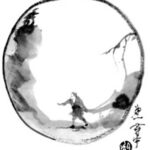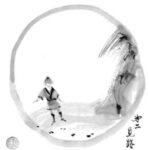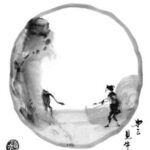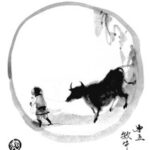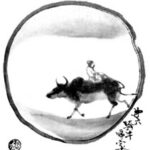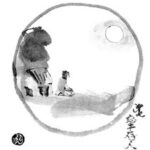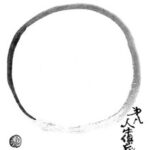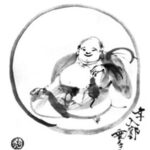Verses Composed by KAKUAN Zenji & Teisho by KUBOTA Ji’un
The Ten Ox-herding Pictures offers an opportunity for the student to deepen their practice through instruction and contemplation.
As always, we begin with beginner’s mind – meaning it makes no difference if you are a newcomer, returning or seeking to deepen in an existing practice. At every point, we begin again
Guidance begins with the introduction, and the stages then broken out for further exploration. You may wish to use this an opportunity for an intensive daily, weekly, or even monthly practice. These words of guidance are simply here for you to use.
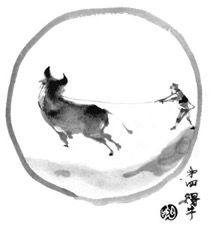 Introduction
Introduction
The “Ten Ox-herding Pictures” are one example of “Ox-herding Pictures.” Here, our essential self is compared to an ox. We seek the ox, grasp it, tame it and finally the self which has always been seeking becomes completely one with the ox. But this also is forgotten so that we now simply carry on our ordinary lives. This is the process described by the Pictures. They show concretely the progression of our practice and are very helpful for a self-examination of our own practice and as encouragement for further practice. I hope then that studying the Ten Ox-herding Pictures will provide an opportunity for all of us to continually examine our practice and also give an indication for self-reflection as to what stage we have now arrived.
Origins
All that is known about the author of the verses to the Ten Ox-herding Pictures, Master KAKUAN Shion, is that he was a disciple of DAIZUI Genjô [1065-1135], the twelfth in the line of Master Rinzai. His dates of birth and death as well as other information are unclear. To each of the ten pictures of the Ten Ox-herding Pictures Master Kakuan has first put a verse and at the end his disciple, Jion (some say Kakuan himself, others say the friend of Kakuan) is said to have put a general introduction and a brief introduction to each one of the verses.
The Ox as Our Essential Self
In the Ten Ox-herding Pictures a little child and an ox are depicted. The ox is the essential self which we are seeking. The little child represents the self of the phenomenal world which wants very much to grasp the essential self – not through concepts and thoughts, but as it really is. This little child (the self of the phenomenal world) is, in fact, always seeking something. It wants money, status, and fame. But life is more than just money, more than just status, and more than just fame. So, the self goes on seeking, now through this philosophy, now through that religion, and endeavors to grow and to make as much progress as possible. There are some who are defeated by the struggle, become neurotic, and even go so far as suicide. For them the spirit of seeking something has operated only as a minus factor; the fact that they are still expending energy and continuing to seek something has not changed.
But why is it that men and women always seek something in this way? According to the teaching of Zen, men and women are essentially perfect and complete, in reality limitless and absolute (this is called “buddha” [hotoke] or “essential buddha-being” [honrai-jôbutsu]). Nevertheless, though being such, they appear phenomenally as imperfect, limited, relative, passing sinful beings (sometimes this is called “ordinary people” [bompu], and sometimes “living beings” [shujô]). Besides, although human being are born this way, they cannot know the essence (Buddha nature) of their own perfection and limitless absoluteness.
The Ten Ox-herding Pictures have concretely depicted the process in which the imperfect, limited, and relative self (the little child) awakens to the perfect, unlimited, and absolute essential self (the ox), grasps it, tames it, forgets it, and completely incorporates it into the personality. But we must stress that these pictures and verses are merely an indication of the way to practice and not an object for conceptual thought. Thus, the study of the Ten Ox-herding Pictures are very useful for those who are actually striving to make clear the true self in Zen through the actual sitting with aching legs. But for those who want only to learn the rationale of Zen I must warn that these pictures and words will be only “white elephants” of no use whatsoever.
Accordingly for the present study I will omit an explanation of the general introduction and proceed to explain the spirit of the particular introduction for each stage. After that I would like to appreciate each line of the verses composed by Master Kakuan himself.

